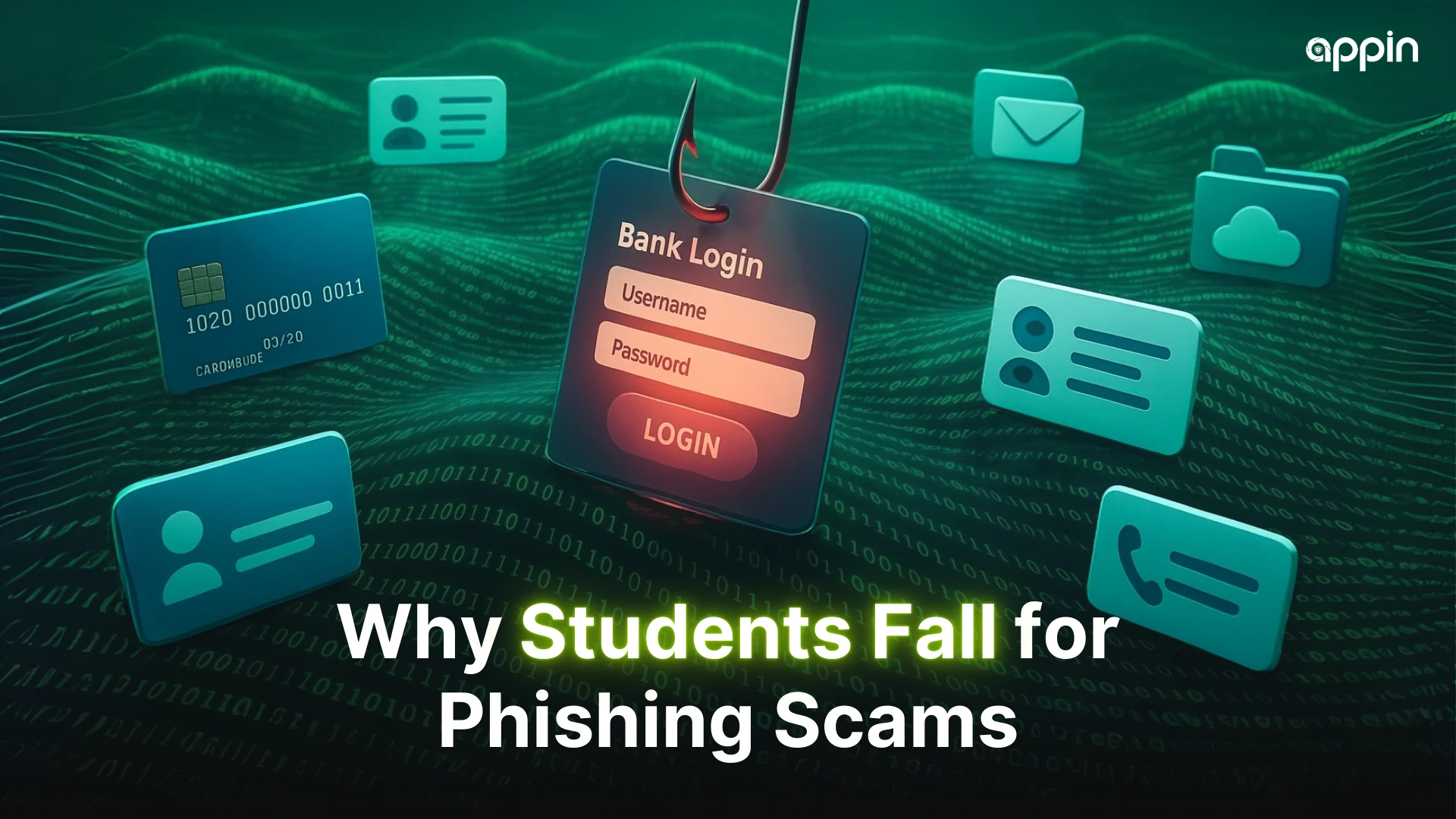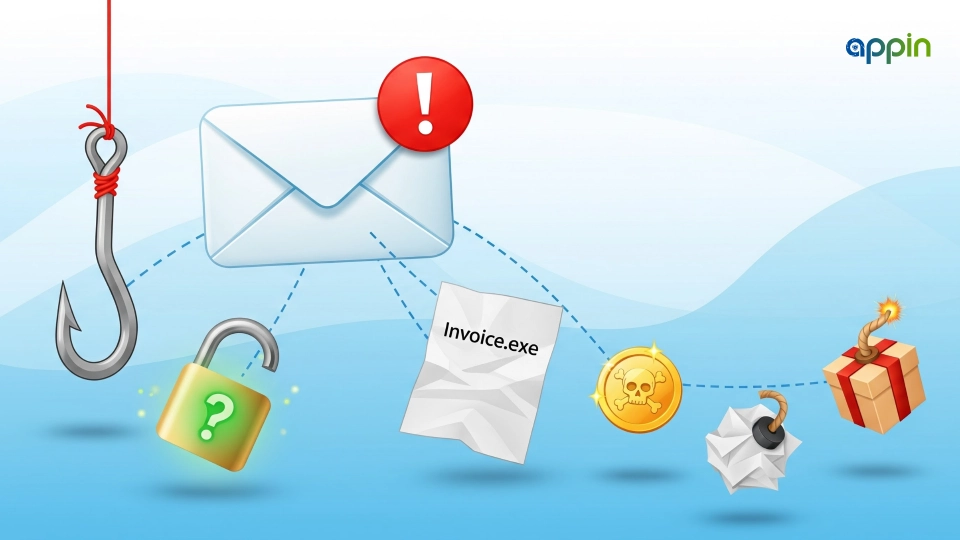Why are students easy targets for phishing scams?
Students are frequent victims of phishing scams because attackers know they are active online and often less cautious about digital security. With emails, social media, and job portals playing such a big role in student life, scammers use these channels to send fake offers and trap them.
The problem is not that students are careless, but that phishing scams for students are designed to look real. Fake scholarships, account warnings, and “free gadgets” are examples of online scams targeting students that push them to click quickly without verifying details.
A lack of awareness about cyber hygiene makes the situation worse. Many students do not double-check sender details or website links, which makes them easy targets.
This blog will help you understand why students are targeted and show you 7 red flags that reveal a phishing attempt before it is too late.
What makes students easy targets for phishing scams?
Students often lack awareness, are highly active online, and respond quickly to offers, which makes them common phishing victims.
Young learners are prime targets because scammers know they have less cybersecurity knowledge. Many students click links in emails, messages, or ads without verifying the source. This explains why students fall for phishing more often than experienced professionals.
Here are key reasons students are targeted:
- High online activity: Social media, job sites, and college platforms are commonly used to send scam messages.
- Curiosity and urgency: Students act quickly on exciting offers or urgent warnings.
- Limited security awareness: They often skip basic checks such as verifying email addresses or checking links.
- Financial vulnerability: Fake scholarships or free giveaways are tempting when money is tight.
The result is that phishing risks for students are much higher compared to other groups. What looks like a harmless link may lead to credential theft, malware, or loss of account access.
Instead of guessing which links are safe, students should invest in structured training. A Cyber Security Certification equips learners with skills to recognize scams, secure their data, and protect themselves online.
Understanding why students are targeted is the first step in defending yourself. Once you know the common tricks, you can avoid falling into traps that cost your privacy and security.
What is the first red flag of a phishing scam? (Suspicious sender address)
The first red flag of a phishing scam is a mismatched or fake sender email address.
Phishing messages often look like they come from banks, universities, or job portals, but a closer look reveals errors. For example, an email that claims to be from your bank may come from support@bank-login123.com
instead of the official domain. Spotting this suspicious email sender is one of the simplest ways to protect yourself.
Common signs of a fake sender address phishing attempt include:
- Small spelling errors in the domain name (e.g., g00gle.com instead of google.com).
- Extra numbers or letters that make the address look unusual.
- Free email accounts (like Gmail or Yahoo) claiming to represent big companies.
- Email addresses that do not match the sender’s name.
Students are more likely to miss these details because they focus on the message content, such as “urgent account warning” or “claim your prize now.” Attackers rely on this oversight to gain access.
The best defense is to check the sender carefully before clicking. Always compare the email domain with the official website of the organization. If it looks strange, do not trust it.
Recognizing the sender is your first shield against phishing, and it only takes a few seconds to verify.
How does urgent or threatening language trick students?
Phishing emails use urgent or threatening language to create panic and push students into acting without thinking.
Scammers know that fear and pressure can override careful judgment. Messages often warn that your account will be blocked, your scholarship canceled, or your exam registration denied unless you act immediately. These are classic phishing urgency tricks.
Typical examples of phishing fear tactics include:
- “Your account will be suspended in 24 hours. Click here to verify.”
- “Payment failed. Update your details now to avoid penalties.”
- “Confirm your email immediately or you will lose access.”
For students, these messages are especially effective because they relate to things that matter: education, money, or online access. Many students click the link or download the attachment before verifying, simply because they do not want to miss out or get into trouble.
The best way to protect yourself is to slow down. Real organizations do not threaten users into taking instant action. If a message feels urgent, double-check it directly on the official website or contact the institution through verified channels.
Learning to spot emotional pressure is key. If a message makes you feel scared or rushed, it is likely a phishing attempt.
Why should you check links before clicking?
You should always check links before clicking because phishing sites often hide fake domains designed to steal your information.
Phishing emails or messages commonly include links that look real but actually redirect to fake websites. These sites are created to capture usernames, passwords, or even bank details. A quick phishing link check can save you from being tricked.
Red flags of fake website links include:
- Misspelled domains (amaz0n.com instead of amazon.com).
- Extra words or numbers in the link (bank-login123.net).
- Links that redirect to unrelated pages.
- Shortened URLs that hide the real address.
Students are often in a hurry and click without hovering over the link to check the full address. This is exactly what attackers expect. One careless click can open the door to credential theft or malware.
The safer approach is simple: hover your mouse over the link (on desktop) or long-press it (on mobile) to preview the actual URL. If it does not match the official site, do not click.
For students pursuing cybersecurity careers, learning how to analyze malicious links is a core skill. With training like Certified Ethical Hacking, you gain the ability to test and identify phishing techniques in a safe, legal environment.
Checking links takes seconds, but it can prevent weeks of damage. Always pause and verify before you act.
Are unexpected attachments a phishing warning?
Yes, unexpected attachments are a major warning sign of phishing because they often contain hidden malware or ransomware.
Attackers send emails that look like official notices, invoices, or job offers but include harmful files. Once opened, these files can infect your computer or phone, stealing personal data or locking your system. These are common phishing attachments.
Typical examples of dangerous files include:
- .zip or .rar archives that unpack malicious programs.
- .doc or .pdf files with embedded scripts that install malware.
- .exe files disguised as useful tools or updates.
Students are more vulnerable because they often expect emails with assignments, interview letters, or certificates. A scammer may send a file titled “Exam Schedule.pdf” or “Job Offer.doc” to gain trust. But inside, it may carry a malware in email attachments that compromises the device.
The safe practice is simple: never open attachments from unknown senders. If you receive a file you were not expecting, verify it with the source before downloading. Keep your antivirus software updated to detect suspicious files.
Being cautious with attachments is one of the easiest ways to avoid phishing traps.
How do “too good to be true” offers fool students?
“Too good to be true” offers fool students because scammers promise rewards like free gadgets, scholarships, or high-paying jobs to trigger excitement and quick action.
Attackers know that students are attracted to opportunities that seem rewarding. They use fake websites, emails, or messages offering prizes and urgent registration links. These are classic free offer phishing scams.
Examples of scholarship phishing scams include:
- Fake portals asking for a “small processing fee” to claim a scholarship.
- Job offers with high salaries requiring you to share login details.
- Contests promising free laptops or smartphones after filling out forms.
These offers work because students are often under financial pressure and eager for opportunities. Scammers exploit this by making the rewards look urgent and limited.
The best defense is skepticism. If an offer looks too perfect, it probably is a scam. Genuine scholarships or job offers never ask for confidential details like passwords or upfront payments.
Students interested in learning how attackers create such fake offers can benefit from courses like the C|EH v13 Ethical Hacker Course, which covers social engineering tactics and defense methods.
Remember: excitement should never replace caution. Always verify opportunities through official sources.
Why do scammers use fake login pages?
Scammers use fake login pages to steal usernames and passwords by tricking students into entering their real credentials on cloned websites.
A fake login page looks almost identical to the official site, such as Instagram, Gmail, or a university portal. The link may be shared through email, text, or social media. Once you type in your details, attackers capture them instantly. These are called phishing login pages.
Common signs of credential stealing scams include:
- The web address does not match the official site.
- The page design looks slightly off or loads slowly.
- After logging in, nothing happens, or you are redirected.
Students often fall for this trick when the link comes with urgent messages like “Confirm your account now” or “Update your password to avoid suspension.” Because the page looks real, they act without checking the URL.
To stay safe, always type the web address yourself instead of clicking on links. Enable two-factor authentication so that even if your password is stolen, attackers cannot access your account easily.
Fake login pages are one of the oldest yet most effective phishing tricks. Learning to spot them is essential for protecting your accounts.
How can poor grammar or formatting expose phishing scams?
Poor grammar, spelling errors, or unprofessional formatting are clear red flags that an email may be a phishing scam.
Legitimate companies and universities rarely send messages filled with mistakes. When you see emails with broken sentences, random capital letters, or design errors, they are often phishing email grammar mistakes.
Common examples include:
- Misspelled words in subject lines (“Urgent Secuirty Update”).
- Incorrect punctuation or random symbols.
- Inconsistent fonts, colors, or logos that look stretched or pixelated.
- Generic greetings like “Dear User” instead of your actual name.
These phishing design errors happen because scammers focus on speed, not quality. They send thousands of emails quickly, hoping some recipients will click before noticing the flaws. Students in a hurry may overlook these details and become victims.
The smart approach is to slow down and check carefully. If a message looks unprofessional or poorly written, treat it with suspicion. Even if the sender claims to be from a trusted organization, errors are a major clue.
If you are interested in understanding how attackers craft such messages and how to analyze them safely, training like a Bug Bounty Diploma teaches structured methods for spotting weaknesses and reporting them responsibly.
Good observation skills can protect you as much as technical tools. Always trust the details.
What should students remember about phishing scams?
Students should remember that phishing scams are designed to trick you with urgency, fake offers, and convincing but false messages, and the best defense is awareness.
Throughout this blog, you learned the main red flags, such as suspicious sender addresses, urgent language, fake links, unexpected attachments, and poor formatting. These clues show that something is not right, and they help you avoid traps that steal your data or compromise your accounts.
Students and fresh graduates are common targets because attackers know you are active online and looking for opportunities. Recognizing these red flags gives you the power to protect yourself before damage happens.
Building strong cybersecurity habits is essential for your future. By staying alert and investing in proper training, you can turn awareness into a valuable skill.
Enquire now with Appin to start your cybersecurity journey and learn how to stay safe online.





